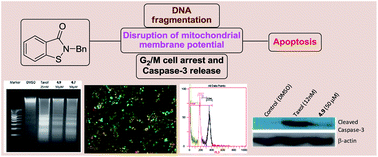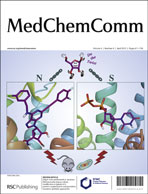Benzisothiazolones arrest the cell cycle at the G2/M phase and induce apoptosis in HeLa cells†
Abstract
Anticancer activities of a series of benzisothiazolones having alkyl, aryl and aralkyl substituents on the nitrogen atom and the mechanistic basis of cytotoxicity are presented. Cellular responses like DNA laddering, disruption of mitochondrial membrane potential and caspase-3 activation on incubation of HeLa cells with representative compounds from this group suggested the induction of apoptosis through an intrinsic pathway. Their ability to arrest the cell cycle at the G2/M phase was confirmed by flow cytometric analysis.


 Please wait while we load your content...
Please wait while we load your content...